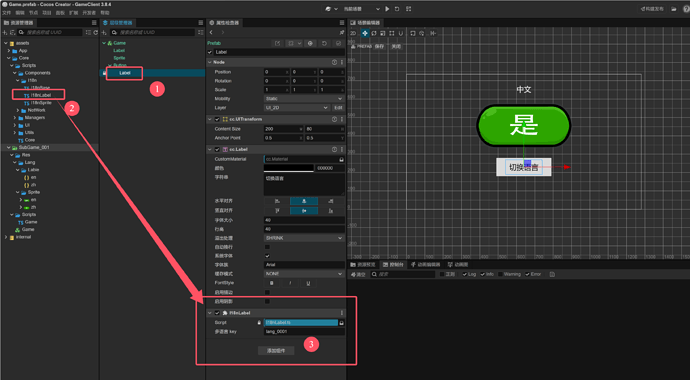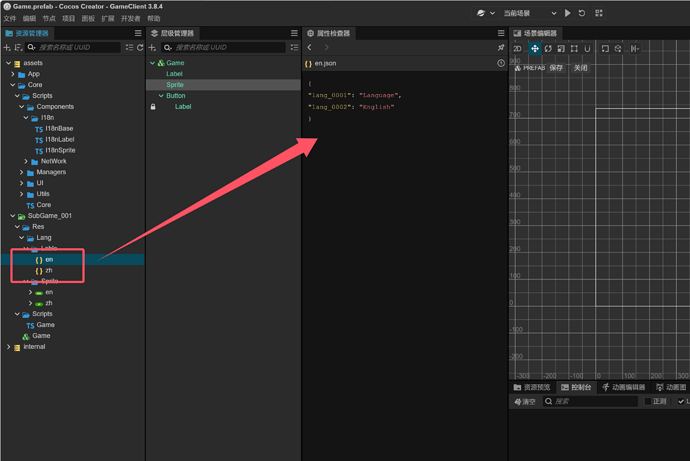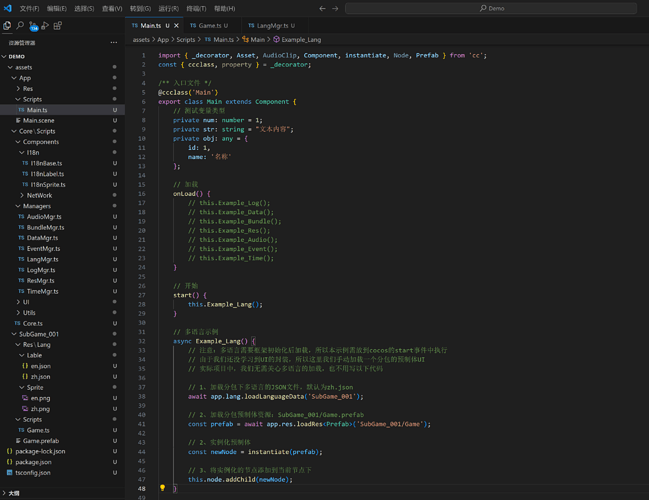接之前的教程:
小白也能写框架之【零、框架实际应用演示】 - Creator 3.x - Cocos中文社区
小白也能写框架之【一、新建框架工程】 - Creator 3.x - Cocos中文社区
小白也能写框架之【二、带颜色的日志管理器】 - Creator 3.x - Cocos中文社区
小白也能写框架之【三、带进度的分包管理器】 - Creator 3.x - Cocos中文社区
小白也能写框架之【四、带加密的数据管理器】 - Creator 3.x - Cocos中文社区
小白也能写框架之【五、资源管理器】 - Creator 3.x - Cocos中文社区
小白也能写框架之【六、音频管理器】 - Creator 3.x - Cocos中文社区
小白也能写框架之【七、事件管理器】 - Creator 3.x - Cocos中文社区
小白也能写框架之【八、任务管理器】 - Creator 3.x - Cocos中文社区
今天给大家分享常用的组件封装【文本和精灵实现多语言】
借鉴了商店里的多语言组件,结合【五、资源管理器】和【七、事件管理器】实现
一、上主菜:
1、文件代码一:assets\Core\Scripts\Components\I18n\I18nBase.ts
import { _decorator, Component } from 'cc';
import { eventMgr } from '../../Managers/EventMgr';
const { ccclass } = _decorator;
/** 多语言抽象组件基类 */
@ccclass('I18nBase')
export abstract class I18nBase extends Component {
/** 组件加载时调用,注册语言更改事件 */
onLoad(): void {
eventMgr.on('langChange', this.refresh, this);
this.refresh();
}
/** 组件销毁时调用,注销语言更改事件 */
onDestroy(): void {
eventMgr.off('langChange', this.refresh);
}
/** 刷新多语言,子类需实现具体逻辑 */
public abstract refresh(): void;
}
2、文件代码二:assets\Core\Scripts\Components\I18n\I18nLabel.ts
import { _decorator, Label, RichText } from "cc";
import { EDITOR } from "cc/env";
import { I18nBase } from "./I18nBase";
import { logMgr } from "../../Managers/LogMgr";
import { langMgr } from "../../Managers/LangMgr";
const { ccclass, property, requireComponent } = _decorator;
/** 用于显示多语言文本,并根据语言变化自动更新内容 */
@ccclass("I18nLabel")
@requireComponent(Label)
@requireComponent(RichText)
export class I18nLabel extends I18nBase {
@property({ displayName: "多语言 key" })
private code: string = "";
/** 多语言标签组件变量 */
private lbl: Label | RichText | null = null;
/** 获取多语言 key */
public get key(): string {
return this.code;
}
/** 设置多语言 key 并刷新内容 */
public set key(value: string) {
this.code = value;
this.refresh();
}
/** 刷新文本内容,根据当前语言设置更新组件的 string 属性 */
public refresh(): void {
if (EDITOR) return; // 编辑器模式下不刷新
if (!this.lbl) {
this.lbl = this.getComponent(Label) || this.getComponent(RichText);
if (!this.lbl) {
logMgr.err("未找到 Label 或 RichText 组件。");
return;
}
}
this.lbl.string = langMgr.getLanguage(this.key);
}
}
3、文件代码三:assets\Core\Scripts\Components\I18n\I18nSprite.ts
import { _decorator, Sprite, SpriteFrame } from "cc";
import { EDITOR } from "cc/env";
import { I18nBase } from "./I18nBase";
import { logMgr } from "../../Managers/LogMgr";
import { langMgr } from "../../Managers/LangMgr";
const { ccclass, property, requireComponent } = _decorator;
/** 存储语言代码与对应的精灵帧 */
@ccclass("I18nSpriteData")
export class I18nSpriteData {
@property({ displayName: "语言代码", tooltip: "如:en、zh等" })
langCode: string = "";
@property({ displayName: "对应精灵", type: SpriteFrame })
spriteFrame: SpriteFrame | null = null;
}
/** 根据当前语言自动更新精灵帧 */
@ccclass("I18nSprite")
@requireComponent(Sprite)
export class I18nSprite extends I18nBase {
@property({ displayName: "多语言精灵数据列表", type: [I18nSpriteData] })
public spList: I18nSpriteData[] = [];
/** 多语言精灵组件变量 */
private sp: Sprite | null = null;
/** 刷新精灵帧,根据当前语言设置更新 Sprite 的 spriteFrame 属性 */
public refresh(): void {
if (EDITOR) return; // 编辑器模式下不刷新
if (!this.sp) {
this.sp = this.getComponent(Sprite);
if (!this.sp) {
logMgr.err("未找到 Sprite 组件。");
return;
}
}
const spriteData = this.spList.find(data => data.langCode === langMgr.lang);
if (spriteData?.spriteFrame) {
this.sp.spriteFrame = spriteData.spriteFrame;
} else {
logMgr.err(`未找到语言代码为 ${langMgr.lang} 的精灵帧。`);
}
}
}
4、文件代码四:assets\Core\Scripts\Managers\LangMgr.ts
import { JsonAsset, director, Director } from "cc";
import { EDITOR } from "cc/env";
import { dataMgr } from "./DataMgr";
import { resMgr } from "./ResMgr";
import { eventMgr } from "./EventMgr";
/**
* 语言管理器
* 提供语言本地化:加载语言包、更改语言设置、获取翻译文本或精灵。
*/
class LangMgr {
/** 记录已加载的分包及其语言 */
private loadedBundles: Record<string, Set<string>> = {};
/** 当前选择的语言 */
private currLang: string;
/** 缓存的语言数据 */
private langData: Record<string, Record<string, string>> = {};
/** 私有构造函数,确保外部无法直接通过new创建实例 */
private constructor() {
if (!EDITOR) {
director.once(Director.EVENT_AFTER_SCENE_LAUNCH, this.init, this);
}
}
/** 单例实例 */
public static readonly instance: LangMgr = new LangMgr();
/** 初始化多语言 */
private async init(): Promise<void> {
this.currLang = dataMgr.getText("language") || "zh";
await this.changeLang(this.currLang);
}
/** 获取当前语言 */
public get lang(): string {
return this.currLang;
}
/** 更改当前语言,并加载必要的语言包 */
public async changeLang(langCode: string): Promise<void> {
if (this.currLang === langCode) return;
this.currLang = langCode;
await Promise.all(
Object.keys(this.loadedBundles).map(bundleName =>
this.loadLanguageData(bundleName, langCode)
)
);
dataMgr.setData("language", langCode);
eventMgr.emit("langChange");
}
/** 异步加载指定分包的指定语言数据 */
public async loadLanguageData(bundleName: string, langCode: string = this.currLang): Promise<void> {
const loadedLanguages = this.loadedBundles[bundleName] || new Set<string>();
if (loadedLanguages.has(langCode)) return;
const path = `${bundleName}/Res/Lang/Lable/${langCode}`;
const langAsset = await resMgr.loadRes<JsonAsset>(path);
this.langData[langCode] = { ...this.langData[langCode], ...langAsset.json };
loadedLanguages.add(langCode);
this.loadedBundles[bundleName] = loadedLanguages;
}
/** 根据键获取对应的翻译文本 */
public getLanguage(key: string, def: string = ""): string {
return this.langData[this.currLang]?.[key] ?? def;
}
}
/** 导出单例实例 */
export const langMgr = LangMgr.instance;
二、结构预览
三、代码示例
1、先建立一个分包,如下图:
2、给分包添加UI,如下图:
先,绑定Game.ts到预制体根节点
然后,依次添加组件,如下图:
3、说明:上面过程中,多语言key和精灵来自分包里的资源,看图:
4、模拟一个游戏设置里,切换语言的功能,打开附加到Game预制体的Game.ts
import { _decorator, Component, Node, Button } from 'cc';
const { ccclass, property } = _decorator;
@ccclass('Game')
export class Game extends Component {
/** 切换语言按钮 */
private btn: Node = null;
private lang: string = "zh";
/** 加载 */
onLoad() {
this.btn = this.node.getChildByName('Button');
if (this.btn) {
this.btn.on(Button.EventType.CLICK, this.onButtonClick, this);
}
}
/** 按钮点击事件处理 */
private onButtonClick() {
if (this.lang == 'zh') {
this.lang = 'en';
} else {
this.lang = 'zh';
}
app.lang.changeLang(this.lang);
}
}
5、最后就是主场景对多语言的调用,看图:
四、效果展示:
五、简单说明:
1、支持Label、RichText、SpriteFrame的多语言
2、通过事件触发多语言的切换,立即生效,无需重启
3、每个分包都有自己独立的多语言资源文件,实现单独更新,减轻更新量
4、支持静态拖拽式多语言(示例中就是静态的),也支持动态调用app.lang.getLanguage(‘key’),一般Tip多语言提示消息使用













